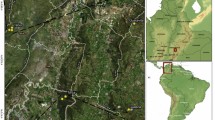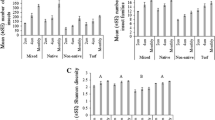Abstract
Disentangling the relationship between shrub vegetation and ground-dwelling arthropods at multiple levels of taxonomic resolution is essential to developing a suitable management strategy for the conservation of shrub-associated arthropod biodiversity in shrubland ecosystems. Using Gobi desert (dominated by shrub species Nitraria sphaerocarpa and Reaumuria soongorica) occurring widely in inland arid areas of northwest China as a model system, we sampled ground-dwelling arthropods by pitfall trapping method under canopies of both shrubs and in intershrub bare areas during spring, summer and autumn. Our aim was to determine whether the presence and species identity of shrubs influence the distribution of ground-dwelling arthropods and whether the influence of shrub presence and species identity differs among trophic and taxonomic groups. At the community level, total arthropod abundance and species richness were significantly greater under shrubs than in intershrub bare habitats, whereas more arthropods were captured under N. sphaerocarpa than under R. soongorica. At the trophic group level, the abundance of predator and decomposer arthropods was significantly greater under shrubs than in intershrub bare habitats, whereas herbivore and decomposer arthropods were more abundant under N. sphaerocarpa than under R. soongorica. At the family level, the abundance of Carabidae, Gnaphosidae, Karschiidae, Tenebrionidae and Thomisidae was consistently much greater under shrubs than in intershrub bare habitats, whereas that of Formicidae, Philodromidae and Tettigoniidae did not differ between the shrub microhabitats and the intershrub bare habitats. However, the abundance of Curculionidae under R. soongorica and the abundance of Geotrupidae under N. sphaerocarpa were significantly lower than that in intershrub bare habitats. N. sphaerocarpa was commonly preferred by arthropods in the families of Curculionidae and Tenebrionidae, whereas R. soongorica was commonly preferred by arthropods in the family Geotrupidae, but shrub species identity did not affect the abundance of the remaining families. Our results suggest that shrubs and species identity play important roles in structuring ground-dwelling arthropod communities, but the response of arthropods differed among trophic or taxonomic groups. This study may have important implications for the conservation of invertebrate biodiversity in Gobi desert ecosystems.






Similar content being viewed by others
References
Aguiar MR, Sala OE (1999) Patch structure, dynamics and implications for the functioning of arid ecosystems. Trends Ecol Evol 14:273–277
Antvogel H, Bonn A (2001) Environmental parameters and microspatial distribution of insects: a case study of carabids in an alluvial forest. Ecography 24:470–482
Barber NA, Marquis RJ (2011) Leaf quality, predators, and stochastic processes in the assembly of a diversity herbivore community. Ecology 92:699–708
Barth RC, Klemmedson JO (1978) Shrub-induced spatial variation of dry matter, nitrogen, and organic carbon. Soil Sci Soc Am J 64:635–639
Begon M, Townsend CR, Harper JL (2006) Ecology: from individuals to ecosystems, 4th edn. Blackwell, Malden
Bezemer TM, Fountain MT, Barea JM, Christensen S, Dekker S, Duyts H, van Hal R, Harvey JA, Hedlund K, Maraun M, Mikola J, Mladenov AG, Robin C, de Ruiter P, Scheu S, Setälä H, Šmilauer P, van der Putten WH (2010) Divergent composition but similar function of soil food webs beneath individual plants: plant species and community effects. Ecology 91:3027–3036
Blight O, Fadda S, Orgeas J, Ponel P, Buisson E, Dutoit T (2011) Using stone cover patches and grazing exclusion to restore ground-active beetle communities in a degraded pseudo-steppe. J Insect Conserv 15:561–572
Bullock JM, Moy IL (2004) Plants as seed traps: inter-specific interference with dispersal. Acta Oecol 25:35–41
Callaway RM (1992) Effect of shrubs on recruitment of Quercus douglasii and Quercus lobata in California. Ecology 73:2118–2128
Charley JL, West NE (1975) Plant-induced soil chemical patterns in some shrub dominated semi-desert ecosystems of Utah. J Ecol 63:945–963
Chen LH, Li FX (1998) Aeolian sandy soil in China. Science Press, Beijing (In Chinese)
Coleman DC, Crossley DA, Hendrix PF Jr (2004) Fundamentals of soil ecology. Elsevier, Oxford
Cushman JH, Waller JC, Hoak DR (2010) Shrubs as ecosystem engineers in a coastal dune: influences on plant populations, communities and ecosystems. J Veg Sci 21:821–831
De Sassi C, Lewis O, Tylianakis JM (2012) Plant-mediated and non-additive effects of two global change drivers on an insect herbivore community. Ecology (in press) doi:http://dx.doi.org/10.1890/11-1839.1
Doblas-Miranda E, Sánchez-Pinero F, Gonzalez-Megías A (2009) Different microhabitats affect soil macroinvertebrate assemblages in a Mediterranean arid ecosystem. Appl Soil Ecol 41:329–335
Facelli JM, Temby AM (2002) Multiple effects of shrubs on annual plant communities in arid lands of South Australia. Austral Ecol 27:422–432
Gabay O, Perevolotsky A, Shachak M (2012) How landscape modulators function: woody plant impact on seed dispersal and abiotic filtering. Plant Ecol 213:685–693
Garner W, Steinberger Y (1989) A proposed mechanism for the formation of ‘fertile islands’ in the desert ecosystem. J Arid Environ 16:257–262
Gutiérrez JR, Meserve PL, Contreras LC, Vásquez H, Jaksic FM (1993) Spatial distribution of soil nutrients and ephemeral plants underneath and outside the canopy of Porlieria chilensis shrubs (Zygophyllaceae) in arid coastal Chile. Oecologia 95:347–352
Haworth K, McPherson GR (1995) Effects of Quercus emoryi on precipitation distribution and microclimate in a semi-arid savanna. J Arid Environ 31:153–170
Lepš J, Šmilauer P (2003) Multivariate analysis of ecological data using CANOCO. Cambridge University Press, Cambridge
Li FR (2008) Presence of shrubs influences the spatial pattern of soil seed banks in desert herbaceous vegetation. J Veg Sci 20:847–859
Li FR, Wang T, Zhang AS, Zhao LY, Kang LF, Chen W (2005) Wind-dispersed seed disposition patterns and seedling recruitment of Artemisia halodendron in a moving sandy land. Ann Bot 96:69–80
Li XY, Liu LY, Gao SY, Ma YJ, Yang ZP (2008) Stemflow in three shrubs and its effect on soil water enhancement in semiarid loess region of China. Agric For Meteorol 148:1501–1507
Li FR, Zhao WZ, Kang LF, Liu JL, Huang ZG (2009a) Seed distribution of four co-occurring grasses around Artemisia halodendron shrubs in a sandy habitat. Acta Oecol 35:444–451
Li FR, Zhao WZ, Liu JL, Huang ZG (2009b) Degraded vegetation and wind erosion influence soil carbon, nitrogen and phosphorus accumulation in sandy grasslands. Plant Soil 317:79–92
Li X, Li XW, Li ZY, Ma MG, Wang J, Xiao Q, Liu Q, Che T, Chen EX, Yan GJ, Hu ZY, Zhang LX, Chu RZ, Su PX, Liu QH, Liu SM, Wang JD, Niu Z, Chen Y, Jin R, Wang WZ, Ran YH, Xin XZ, Ren HZ (2009c) Watershed allied telemetry experimental research. J Geophys Res 114:D22103. doi:10.1029/2008JD011590
Liu JL, Li FR, Liu QJ, Niu RX (2010) Seasonal variation in soil fauna community composition and diversity in an arid desert ecosystem of the Heihe Basin. J Des Res 30:342–349 (In Chinese with English abstract)
Liu RT, Zhao HL, Zhao XY, Drake S (2011) Facilitative effects of shrubs in shifting sand on soil macro-faunal community in Horqin Sand Land of Inner Mongolia, Northern China. Eur J Soil Biol 47:316–321
López-Pintor A, Gómez Sal A, Benayas JMR (2006) Shrubs as a source of spatial heterogeneity: the case of Retama sphaerocarpa in Mediterranean pasture of central Spain. Acta Oecol 29:247–255
Lövei GL, Sunderland KD (1996) Ecology and behavior of ground beetles (Coleoptera: Carabidae). Ann Rev Entomol 41:231–256
Mauchamp A, Janeau JL (1993) Water funneling by the crown of Fluorensia cernua, a Chihuahuan desert shrub. J Arid Environ 25:299–306
Mazía CN, Chaneton EJ, Kitzberger T (2006) Small-scale habitat use and assemblage structure of 6 ground-dwelling beetles in a Patagonian shrub steppe. J Arid Environ 67:177–194
Moro MJ, Pugnaire FI, Haase P, Puigdefábregas J (1997) Effect of the canopy of Retama sphaerocarpa on its understorey in a semi-arid environment. Funct Ecol 11:425–431
Mueller-Dombois D, Ellenberg H (1974) Aims and methods of vegetation ecology. Wiley, New York
Nielsen UN, Osler GHR, Campbell CD, Burslem DFRP, van der Wal R (2010) The influence of vegetation type, soil properties and precipitation on the composition of soil mite and microbial communities at the landscape scale. J Biogeogr 37:1317–1328
Parmenter RR, Parmenter CA, Cheney CD (1989) Factors influencing microhabitat partitioning in arid-land darkling beetles (Tenebrionidae): temperature and water conservation. J Arid Environ 17:57–67
Pen-Mouratov S, Rakhimbaev M, Barness G, Steinberger Y (2004) Spatial and temporal dynamics of nematode populations under Zygophyllum dumosum in arid environments. Eur J Soil Biol 40:31–46
Peterson AC, Hendrix PF, Haydu C, Graham RC, Quideau SA (2001) Single-shrub influence on earthworms and soil macroarthropods in the southern California chaparral. Pedobiologia 45:509–522
Pugnaire FI, Lázaro R (2000) Seed bank and understorey composition in a semi-arid environment: the effect of shrub age and rainfall. Ann Bot 86:807–813
Ren GD, Yu YZ (1999) The darkling beetles from deserts and semideserts of China (Coleoptera: Tenebrionidae). Hebei University Press, Baoding (In Chinese)
Rogers LE, Woodley NE, Sheldon JK, Beedlow PA (1988) Diets of darkling beetles (Coleoptera: Tenebrionidae) within a shrub-steppe ecosystem. Ann Entomol Soc Am 81:782–791
Rosagno CM, del Valle HF, Videla L (1991) The influence of shrubs on some chemical and physical properties of an aridic soil in north-eastern Patagonia, Argentina. J Arid Environ 20:179–188
Rosin ZM, Myczko L, Skórka P, Lenda M, Moroń D, Sparks TH, Tryjanowski P (2012) Butterfly responses to environmental factors in fragmented calcareous grasslands. J Insect Conserv 16:321–329
Shachak M, Boeken B, Groner E, Kadmon R, Lubin Y, Meron E, Ne’Eman G, Perevolotsky A, Shkedy Y, Ungar ED (2008) Woody species as landscape modulators and their effects on biodiversity patterns. Bioscience 58:209–221
Shumway SW (2000) Facilitative effects of a sand dune shrub on species growing beneath the shrub canopy. Oecologia 124:138–148
Slobodchikoff CN (1983) Water balance and temperature preferences, and their role in regulating activity times of tenebrionid beetles. Oikos 40:113–119
Stapp P (1997) Microhabitat use and community structure of darkling beetles (Coleoptera: Tenebrionidae) in shortgrass prairie: effects of season, shrub cover and soil type. Am Midl Nat 137:298–311
Su YZ, Zhao HL, Li YL, Cui JY (2004) Influencing mechanisms of several shrubs on soil chemical properties in semiarid Horqin sandy land, China. Arid Land Res Manage 18:1–13
Sylvain ZA, Wall DH (2011) Linking soil biodiversity and vegetation: implications for a changing planet. Am J Bot 98:517–527
Titus JH, Nowak RS, Smith SD (2002) Soil resource heterogeneity in the Mojave Desert. J Arid Environ 52:269–292
Valiente-Banuet A, Ezcurra E (1991) Shade as a cause of association between the cactus Neobuxbaumia tetetzo and the nurse plant Mimosa luisana in the Tehuacán Valley, Mexico. J Ecol 79:961–971
Vetaas OR (1992) Micro-site effects of trees and shrubs in dry savannas. J Veg Sci 3:337–344
Wang XP, Wang ZN, Berndtsson R, Zhang YF, Pan YX (2011) Desert shrub stemflow and its significance in soil moisture replenishment. Hydrol Earth Syst Sci 15:561–567
Wardle DA, Bardgett RD, Klironomos JN, Setälä H, van der Putten WH, Wall DH (2004) Ecological linkages between aboveground and belowground biota. Science 304:1629–1633
Wilder SM, Holway DA, Suarez AV, Eubanks MD (2011) Macronutrient content of plant-based food affects growth of a carnivorous arthropod. Ecology 92:325–332
Wise DH (1985) Negative correlation between numbers of a darkling beetle and a carabid predator. Southwest Nat 30:148–150
Yin WY (2000) Pictorial keys to soil animals of China. Science Press, Beijing (In Chinese)
Zhou ZY, Zhu ZY, Liu ZL (2010) Restoration of degraded arid desert ecosystems and sustainable development. Science Press, Beijing (In Chinese)
Zhou ZY, Li FR, Chen SK, Zhang HR, Li G (2011) Dynamics of vegetation and soil carbon and nitrogen accumulation over 26 years under controlled grazing in a desert shrubland. Plant Soil 341:257–268
Ziesche TM, Roth M (2008) Influence of environmental parameters on small scale distribution of soil dwelling spiders in forests: what makes the difference, tree species or microhabitat? For Ecol Manage 255:738–752
Acknowledgments
We thank two anonymous referees for helpful comments on an earlier version of this manuscript. We also thank all technicians for assistance in the field. This work was supported by the grants 31170496 and 91025021 from the National Natural Science Foundation of China and the grant 41125002 from the National Science Foundation for Distinguished Young Scholars of China.
Author information
Authors and Affiliations
Corresponding author
Rights and permissions
About this article
Cite this article
Li, FR., Liu, JL., Liu, CA. et al. Shrubs and species identity effects on the distribution and diversity of ground-dwelling arthropods in a Gobi desert. J Insect Conserv 17, 319–331 (2013). https://doi.org/10.1007/s10841-012-9512-1
Received:
Accepted:
Published:
Issue Date:
DOI: https://doi.org/10.1007/s10841-012-9512-1




